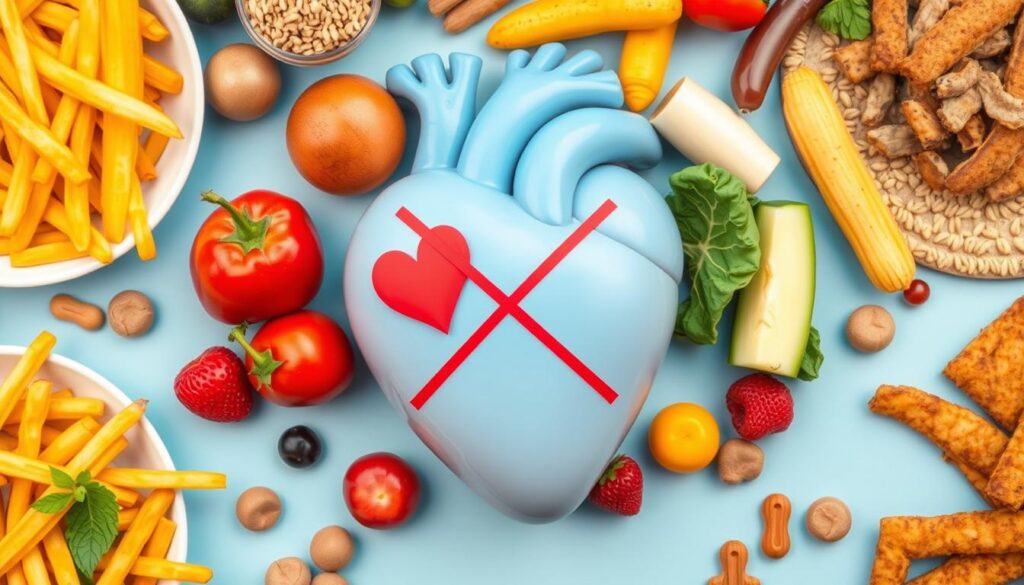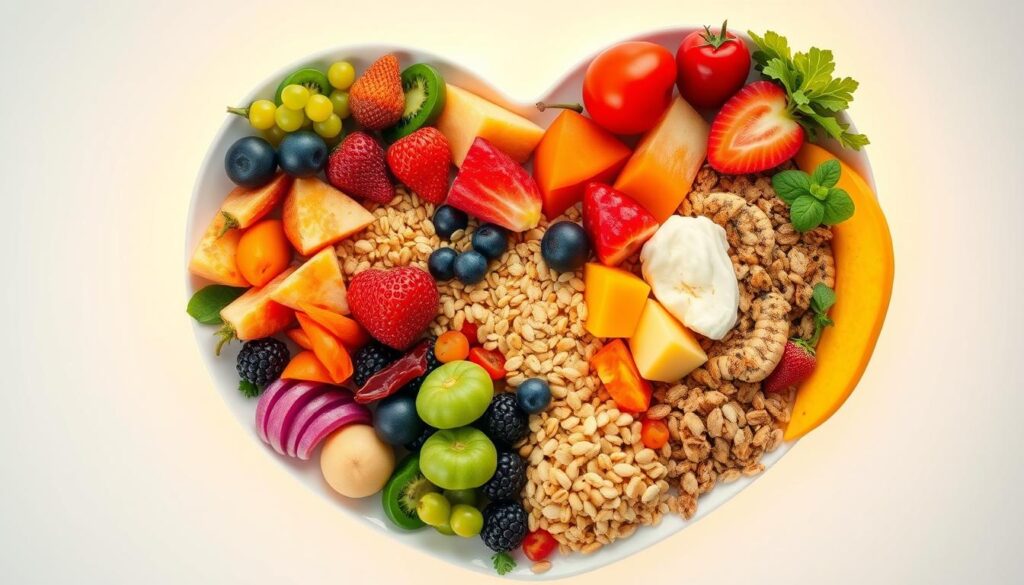Are you eating foods that harm your heart without knowing it? The truth about trans fats might shock you. In this guide, we’ll expose the dangers of trans fats and help you choose better foods. You’ll learn how to improve your health and live a happier life.
Key Takeaways
- Understand the difference between natural and artificial trans fats and their impact on heart health.
- Learn how to read nutrition labels and identify hidden sources of trans fats.
- Discover healthy alternatives to trans fat-containing foods and make smarter grocery choices.
- Explore the connection between trans fats and processed foods, and how to navigate restaurant menus.
- Gain insights into the FDA’s ban on trans fats and its implications for your health.
Understanding Trans Fats and Their Impact on Heart Health
Keeping our heart healthy is key, and the fats we eat play a big role. Trans fats are especially bad for our heart. Let’s explore why these fats are harmful and how they affect our cholesterol.
Natural vs. Artificial Trans Fats
There are two types of trans fats: natural and artificial. Natural trans fats are found in small amounts in some animal products. But, it’s the artificial trans fats, or hydrogenated oils, that are the real problem.
These artificial fats are made by adding hydrogen to vegetable oils. This makes them solid and stable, which helps them last longer and improves the taste of processed foods.
The Science Behind Trans Fat Health Risks
Many studies have found that eating hydrogenated oils is bad for our health. These artificial trans fats can raise cholesterol levels. They increase the bad LDL cholesterol and lower the good HDL cholesterol.
This imbalance can cause plaque to build up in our arteries. This increases the risk of heart disease, stroke, and other heart problems.
How Trans Fats Affect Cholesterol Levels
Trans fats affect our cholesterol levels in a complex way. They can mess with our body’s natural cholesterol regulation. This makes it harder for our liver to keep cholesterol levels in check.
As a result, trans fats can lead to an unhealthy cholesterol ratio. This puts our heart health at risk.
Knowing how trans fats work is important for making good food choices. By understanding their dangers, we can make better choices to protect our heart health.

The FDA Ban on Trans Fats: What You Need to Know
The United States Food and Drug Administration (FDA) has banned artificial trans fats in our food. This move is a big step towards a healthy lifestyle. It will change what we see in stores and our choices when eating out.
The FDA made this decision based on strong science. It shows that trans fats increase heart disease risk. By avoiding these fats, we can improve our heart health and lower chronic illness rates.
Now, food makers and restaurants can’t use partially hydrogenated oils anymore. This means they must change many of their products. They’re looking for new, healthier options that still taste good.
- The FDA’s trans fat ban applies to all foods sold in the United States, including those imported from other countries.
- Food producers have until January 2021 to remove all artificial trans fats from their products, or face enforcement action.
- Restaurants and food service establishments must also eliminate the use of partially hydrogenated oils in their cooking and preparation processes.
As we enter this new era of food regulations, staying informed is key. Knowing about the FDA’s ruling helps us make better choices. These choices support our heart health and a healthy lifestyle for our families.

“Removing artificial trans fats from the food supply is one of the most significant public health nutrition achievements in a generation.”
Reading Nutrition Labels to Identify Hidden Trans Fats
Understanding nutrition labels is key for a healthy lifestyle. It’s important to spot hidden trans fats, which harm our heart health. Let’s explore how to become a pro at reading labels.
Common Misleading Label Terms
Some label terms can be tricky. Words like “partially hydrogenated oils,” “shortening,” and “margarine” hide unhealthy trans fats. Always check the ingredient list to make smart choices.
Understanding Serving Sizes and Trans Fat Content
It’s vital to know serving sizes and trans fat content. The listed serving size might not match what we eat. By looking at serving sizes and trans fat per serving, we can judge a product’s nutritional value better.
Using the Food Scan Genius App for Label Verification
Modern tech helps us choose healthier foods. The Food Scan Genius app makes reading labels easy. Just scan a product’s barcode, and it shows trans fats and nutritional info. This app is a big help in making good grocery store choices.
“Becoming a savvy nutrition label reader is the first step towards a healthier lifestyle. With the right tools and knowledge, we can take control of our food choices and prioritize our heart health.”
By learning to read labels and using the Food Scan Genius app, we can shop with confidence. We ensure our food choices are nutritious and trans fat-free.
No Trans Fats: Making Smart Food Choices
Keeping your heart healthy starts with cutting out trans fats from your diet. It’s easier than you think to cook and eat clean. Here are some tips to help you make better food choices and lower your trans fat intake.
Embrace Natural Alternatives
Instead of processed foods with artificial trans fats, try natural oils and fats. Use olive oil, avocado oil, or nut oils for cooking and baking. These options taste great and are good for your heart.
Read Labels Carefully
Always read nutrition labels when you shop. Look out for “hydrogenated” or “partially hydrogenated oils,” which mean trans fats. Also, check serving sizes and the total trans fat content, even if it says “0 grams trans fat.”
Plan Ahead with Meal Prep
- Make meals in advance with trans fat-free ingredients.
- Choose whole, unprocessed foods like fruits, veggies, legumes, and grains.
- Try heart-healthy recipes that highlight the natural flavors of these foods.
By being proactive with clean eating and healthy cooking, you can easily cut down on trans fats. This supports your heart health. Remember, small steps can make a big difference in how you feel.
| Unhealthy Oils | Heart-Healthy Alternatives |
|---|---|
| Partially Hydrogenated Oils | Olive Oil |
| Vegetable Shortening | Avocado Oil |
| Margarine | Coconut Oil |
| Vegetable Oil | Nut Oils (e.g., Walnut, Almond) |
“Choosing trans fat-free options is one of the easiest and most impactful ways to support your heart health.”
Healthy Alternatives to Trans Fat-Containing Foods
Goodbye to trans fats doesn’t mean losing flavor or variety. There are many tasty, heart-healthy options that meet your cravings without harming your health. Let’s look at some delicious choices that make you feel great inside.
Natural Oil Substitutes
Replace trans-fat oils like partially hydrogenated vegetable oil with extra-virgin olive oil, avocado oil, or coconut oil. These oils add great taste and offer monounsaturated and polyunsaturated fats. These fats can lower cholesterol and boost heart health.
Better Baking and Cooking Options
For healthy cooking, simple swaps can make a big difference. Use mashed avocado, unsweetened applesauce, or nut butters instead of butter. For sautéing and roasting, choose heart-healthy oils. Try whole grains, legumes, and vegetables for tasty, low-saturated fat dishes.
Heart-Healthy Snack Alternatives
Want something crunchy or sweet? Skip trans-fat snacks like chips and cookies. Opt for fresh fruit, raw nuts, dark chocolate, or air-popped popcorn. These nutrient-dense snacks are tasty and packed with vitamins, minerals, and fiber for heart health.
With a bit of creativity and focus on healthy cooking, you can enjoy your favorite flavors without trans fats. Try these wonderful alternatives and start your journey to a happier, healthier life.
The Connection Between Trans Fats and Processed Foods
In today’s fast world, convenience can harm our health. Processed foods, seen as quick fixes, often hide trans fats. These fats can lead to heart disease and other serious health problems.
There’s a strong link between trans fats and processed foods. Many snacks, baked goods, and frozen meals contain these harmful fats. They are often labeled as “partially hydrogenated oils” or other confusing terms. Knowing this is key for those who want to eat clean and keep their heart healthy.
Luckily, food regulations have improved. The FDA has worked to limit trans fats. But we still need to be careful. Reading labels and avoiding foods with hydrogenated oils helps us make better choices for our heart.
Being aware of the dangers of trans fats in processed foods empowers us. It helps us make healthier choices and lower our risk of heart disease. Understanding the science behind these fats and their presence in our favorite foods is the first step to a healthier diet.
Processed foods often contain hidden trans fats that can lead to serious heart health issues. Choosing whole, minimally processed options is key to a clean eating approach.”
| Processed Food | Trans Fat Content |
|---|---|
| Microwave popcorn | 0.5 grams per serving |
| Frozen pizza | 1 gram per slice |
| Vegetable shortening | 2 grams per tablespoon |
| Margarine | 2.5 grams per tablespoon |
By knowing the dangers of trans fats in processed foods, we can make better choices. Reading labels, avoiding hydrogenated oils, and choosing minimally processed foods is a big step towards a healthier life.
Tips for Trans Fat-Free Grocery Shopping
Shopping for groceries without trans fats can seem hard. But, with smart strategies, you can pick healthy foods easily. Here are some tips to help you shop wisely without trans fats.
Creating a Heart-Healthy Shopping List
Plan your shopping trip before you go. Make a list of whole foods like fruits, lean meats, and healthy oils. Always check nutrition labels for “0 grams trans fat.” The Food Scan Genius app can also help find trans fat-free foods quickly.
Navigating Restaurant Menus and Fast Food
Eating out can be tricky, but you can make better choices. Choose dishes that are grilled, baked, or sautéed. Go for lean proteins, lots of veggies, and healthy fats like avocado or olive oil. For fast food, look for places that don’t use trans fats.
Staying informed and making smart choices is key to avoiding trans fats. Use the Food Scan Genius app and watch nutrition labels. This will help you live a healthier life, even when eating out.
Conclusion
We’ve reached the end of our journey into heart-healthy eating. It’s been quite a trip! We’ve learned a lot, from the dangers of trans fats to how to read labels.
Small steps towards a diet without trans fats can make a big difference. By choosing clean eating and healthier options, we can live better. Every choice we make helps us get closer to being happier and healthier.
Let’s keep going and nourish our bodies and minds with the best nature offers. Together, we can make heart health a priority and leave trans fats behind. Here’s to a life of clean eating and a strong heart!
FAQ
What are trans fats and why are they harmful to heart health?
Trans fats are created through an industrial process. They are not natural fats. Studies show they increase “bad” LDL cholesterol and lower “good” HDL cholesterol. This raises the risk of heart disease and stroke.
How can I identify trans fats on nutrition labels?
Check the Nutrition Facts panel for the “Trans Fat” line. Any amount listed means the product has trans fats. Watch out for terms like “partially hydrogenated” or “shortening,” as they might hide trans fats.
What are the FDA regulations surrounding trans fats?
In 2018, the FDA banned partially hydrogenated oils. This is the main source of artificial trans fats. The goal is to remove trans fats from foods and improve heart health across the country.
How can I find trans fat-free alternatives to processed foods?
Choose whole, minimally processed foods like fruits, veggies, lean proteins, and whole grains. Read labels for “trans fat-free” products. Apps like Food Scan Genius can help find these options quickly.
What are some tips for maintaining a trans fat-free diet when eating out?
Opt for grilled, baked, or sautéed foods instead of fried ones. Avoid baked goods, fried foods, and some sauces and dressings. Ask your server about cooking oils to make sure your meal is trans fat-free.





